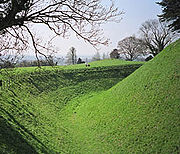
Ditch (fortification)
Encyclopedia

Military engineer
In military science, engineering refers to the practice of designing, building, maintaining and dismantling military works, including offensive, defensive and logistical structures, to shape the physical operating environment in war...
ing is an obstacle, designed to slow down or break up an attacking force, while a trench
Trench
A trench is a type of excavation or depression in the ground. Trenches are generally defined by being deeper than they are wide , and by being narrow compared to their length ....
is intended to provide cover
Cover (military)
In military combat, the concept of cover refers to anything which is capable of physically protecting an individual from enemy fire. This differentiates it from the similar concept of concealment, in that an object or area of concealment only affords the benefit of stealth, not actual protection...
to the defenders. In military fortifications the side of a ditch (or gorge) farthest from the enemy and closest to the next line of defence is known as the scarp while the side of a ditch closest to the enemy is known as the counterscarp
Counterscarp
A scarp and a counterscarp are the inner and outer sides of a ditch used in fortifications. In permanent fortifications the scarp and counterscarp may be encased in stone...
.
Uses
In medieval fortificationMedieval fortification
Medieval fortification is military methods of Medieval technology that covers the development of fortification construction and use in Europe roughly from the fall of the Western Roman Empire to the Renaissance...
, a ditch was often constructed in front of a defensive wall
Defensive wall
A defensive wall is a fortification used to protect a city or settlement from potential aggressors. In ancient to modern times, they were used to enclose settlements...
to hinder mining and escalade
Escalade
Escalade is the act of scaling defensive walls or ramparts with the aid of ladders, and was a prominent feature of siege warfare in medieval times...
activities from an attacker. When filled with water, such a defensive ditch is called a moat
Moat
A moat is a deep, broad ditch, either dry or filled with water, that surrounds a castle, other building or town, historically to provide it with a preliminary line of defence. In some places moats evolved into more extensive water defences, including natural or artificial lakes, dams and sluices...
.
Later star fort
Star fort
A star fort, or trace italienne, is a fortification in the style that evolved during the age of gunpowder, when cannon came to dominate the battlefield, and was first seen in the mid-15th century in Italy....
s designed by military engineers like Vauban
Vauban
Sébastien Le Prestre, Seigneur de Vauban and later Marquis de Vauban , commonly referred to as Vauban, was a Marshal of France and the foremost military engineer of his age, famed for his skill in both designing fortifications and breaking through them...
, comprised elaborate networks of ditches and parapet
Parapet
A parapet is a wall-like barrier at the edge of a roof, terrace, balcony or other structure. Where extending above a roof, it may simply be the portion of an exterior wall that continues above the line of the roof surface, or may be a continuation of a vertical feature beneath the roof such as a...
s, carefully calculated so that the soil
Soil
Soil is a natural body consisting of layers of mineral constituents of variable thicknesses, which differ from the parent materials in their morphological, physical, chemical, and mineralogical characteristics...
for the raised earthworks
Earthworks (engineering)
Earthworks are engineering works created through the moving or processing of quantities of soil or unformed rock.- Civil engineering use :Typical earthworks include roads, railway beds, causeways, dams, levees, canals, and berms...
was provided, as nearly as possible, entirely by the excavations whilst also maximising defensive firepower.
Today ditches are obsolescent as an anti-personnel obstacle, but are still often used as anti-vehicle obstacles (see also berm
Berm
A berm is a level space, shelf, or raised barrier separating two areas. Berm originates in the Middle Dutch and German berme and came into usage in English via French.- History :...
).
A fence concealed in a ditch is called a ha-ha.

